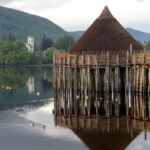Caledonia
Celts and Romans in Northern Britain
“The whole of Britain has likened Livius […] and Fabius Rectus to an elongated key or a double ax. […] The sky is darkened by frequent rain and fog; you do not know anything about severe cold weather. […] Yes, one assures, if clouds do not prevent, one sees the glitter of the sun during the night, and it does not go under and up, but only over. ”
Tacitus – Roman historian and Senator – about Caledonia (latin-celtic name of Scotland) in his work Agricola Chapter 10/12.
When and how many Celts came to Scotland can not be said by archeology. However, it is believed that the first around 500 BC settled in south and southwest Scotland. Signs seem to be the increased construction of Hill Forts. Hill settlements surrounded by expansive ramparts. Today, 1,500 Hill Forts are known, most of them south of the Clyde-Firth of Forth line.
The Celtic immigrants, however, did not seem to have much influence on the popikards in northeastern Scotland and the Highlands. Here the post-glacial, non-Indo-European roots remained strongest.
Duns, Crannogs and Brochs
Also around 500 BC the secrets of iron processing came to the north. This had particular influence on the weapon technology. It was also the time in which the hitherto Bronze Age round houses were expanded into small fortresses. Starting from their center in southwest Scotland, Duns spread out on rocky outcropped houses. On a round ground plan thick walls (without mortar) were built and provided with a roof.

Another early form was Crannogs. Pile-built wooden houses resting on an artificial island on the banks of a Loch. Despite the simple construction, it is believed that they were rather inhabited by wealthy families, as in them often merchandise from the Roman Empire were found.

A development – and unique in Europe – of the Duns were the Brochs. They are up to 15m high round towers made of dry stone walls with several floors, the walls thick down tapering upwards. The special feature is the double outer walls, in which there is a staircase over which you could reach the upper cells. On the ground floor was a central room with a fireplace, from which often several chambers branched off. The only opening was the door, there were no windows. Nothing is known about the appearance and material of the roofs.
Futile attempts
Since the Romans failed to penetrate into the north, Scotland was never Romanised. At best, they could show presence in the area between Hadrian’s Wall and the Highlands. Gaius Julius Ceasar undertook 55/54 BC first expeditions to Britain. But under Emperor Claudius, it took another 30 years, the British tribes by an invasion 43 AD to permanently pacify. In the year 79 AD undertook-with several campaigns in the Lowlands- Gnaeus Iulius Agricola an advance into the north. In his writings, his son-in-law Tacitus explains why it is easy for the Romans to conquer much of the island.
“Because the tribes did not succeed in uniting against the enemy – individually they could easily be defeated.”

Until 84 AD, the tribes north of the Clyde River and Fart of Forth had learned to do so.
The Caledonii were the most powerful of these Highland tribes. According to them, Northern Britain was named by the Romans Caledonia (hard country, Picts land). The Piktenfürst Calgacus – the name is only handed down in Roman form – led a tribal alliance and could oppose the mons graupius (probably Bennachie) Roman troops 30,000 warriors. He urged them to fight together against the invaders for freedom because he wanted to prevent his people being made slaves and exploited, but they were subject to “modern” military technology. After Agricola was ordered back to Rome by the emperor-he thought the success was politically detrimental to him-the Roman troops withdrew behind the Tyne-Solway line and fortified about 120 AD the border with Hadrian’s Wall.
20 years later, around 142 AD, another attempt was made and the Antoninus Wall was erected.
Once again, the Roman Empire was unable to establish itself permanently, and peace with the Caledonii and Maeatae had to be bought dearly. Further experiments under Emperor Septimius Severus 208-11 AD and 306 AD also fail. You could not get beyond Hadrian’s Wall. Only smaller outposts could assert themselves between the two ramparts. By careful cultural contacts – the tribes had become accustomed to the Romans – emerged, probably influenced by Roman construction and carpentry, new architectural forms. In East Scotland, for example, Wheelhouses dating back to the 5th century AD were built. These were round stone houses which had spokes in the middle, with individual dividing walls, chambers.
There were even more influences.
The demarcation between the Picts and the Southern Scottish tribes grew as these contacts with the Romans held. While the Pict continued to paint their skin with blue color, the latter gradually abandoned the tradition of tattooing, felt more akin to the Welsh, and began to regard the Picts as backward.